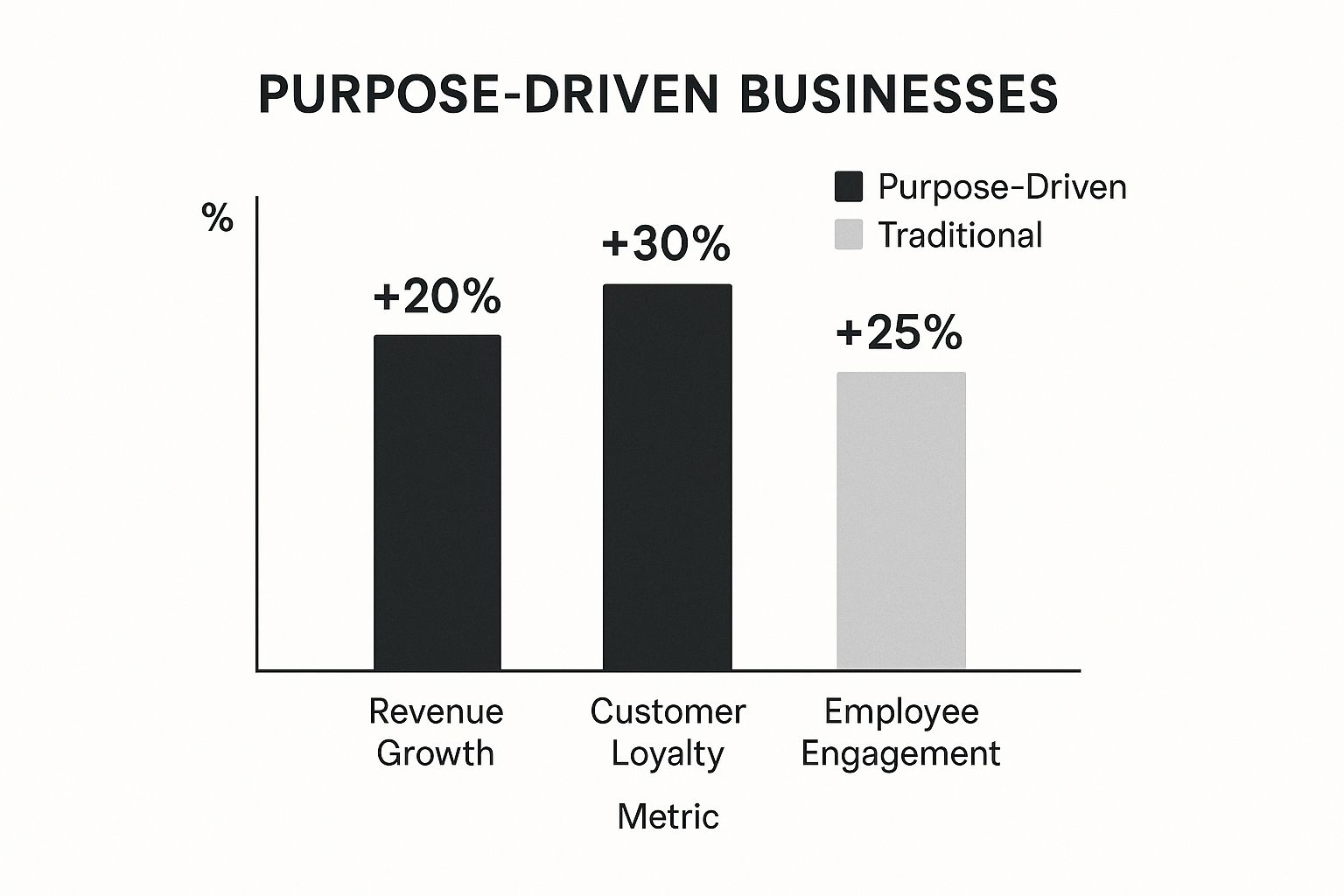Beyond the Buzzword: What Makes a True Purpose-Driven Business

The term "purpose-driven business" is everywhere these days. But true purpose isn't just a trendy marketing strategy; it's the very heart and soul of why a business exists, far beyond simply generating profit. It's about weaving a mission of positive impact into every fiber of the company's operations. It’s about making a real difference, not just coming up with a catchy slogan.
Defining True Purpose
Authentic purpose isn't something you can just slap on a website. It's deeply ingrained in a company's core values and shows up in everything it does. For example, if a company claims to prioritize sustainability, its actions must reflect that commitment through eco-friendly practices. Simply adding "sustainability" to a mission statement isn't enough. True purpose must resonate deeply with everyone involved, both the internal team (employees) and the external community (customers and beyond).
The Difference Between Performative Purpose and Authentic Purpose
Sadly, many businesses fall into the trap of purpose-washing. This is when a company talks a big game about its purpose but doesn't actually live up to it. This can create skepticism and erode trust with customers, who are becoming increasingly savvy at spotting inauthenticity. A truly purpose-driven business, on the other hand, consistently walks the walk. Their actions align perfectly with their stated mission, building strong integrity and fostering trust. For a deeper dive into this, check out this helpful article: How to master purpose-driven branding.
The Impact of Authentic Purpose
According to Deloitte Insights, purpose-driven companies are seeing significant gains. They experience higher market share growth, expanding three times faster on average than their competitors. They also enjoy increased workforce and customer satisfaction. This isn't a niche trend, either. It's happening across the board, globally, as more businesses embrace the power of a clear and authentic mission. This clearly demonstrates that purpose isn't just about "doing good"; it's a powerful engine for business success.
Embedding Purpose in Daily Operations
Turning a big-picture mission into concrete action takes real work. It involves integrating purpose into every facet of the business. This means everything from how products are developed and marketed to how customer service is handled and how employees are engaged. For instance, a purpose-driven company might prioritize ethical sourcing of materials, invest in local community programs, or give employees opportunities to contribute to social causes.
Looking Ahead: The Evolving Landscape of Purpose
To understand the future of purpose-driven businesses, it's helpful to see how marketing itself is changing. Dominate Dental's article on The Future Of Dental Marketing offers insightful context here. Ultimately, the future of purpose-driven business lies in its adaptability. It's about responding to evolving customer expectations and societal shifts. This includes radical transparency, demonstrating measurable impact, and fostering open communication with everyone involved. Purpose isn't a static destination, but an ongoing journey that requires constant nurturing and integration into the very core of a business.
The ROI of Purpose: When Doing Good Actually Pays Off
Forget the feel-good stories. A purpose-driven business isn't just about making you feel warm and fuzzy inside. It's about achieving measurable results that impact your bottom line. This exploration delves into the tangible financial benefits of building a business with heart, moving beyond emotional narratives to the compelling evidence of hard data. We'll examine how purpose translates to profit, looking closely at key metrics like customer acquisition costs and the power of price premiums.
Measuring What Matters: Key Metrics for Purpose-Driven ROI
Which metrics truly matter when assessing the return on investment (ROI) of purpose? Here's where to focus your attention:
- Revenue Growth: Does your purpose resonate deeply with your customers, leading to increased sales and market share?
- Customer Loyalty: Are customers not just making a single purchase, but sticking around for the long haul, becoming passionate brand advocates who spread the word about your company?
- Employee Engagement: Is your purpose attracting and retaining top talent, boosting productivity and minimizing costly employee turnover?
- Brand Value: How does your purpose contribute to the overall perceived worth of your brand, enhancing its reputation and influence in the marketplace?
- Customer Acquisition Cost (CAC): Does a strong, authentic purpose lower your marketing spend by attracting customers organically, drawing them in through shared values and genuine connection?
The infographic below visually represents the positive correlation between purpose and key metrics like Revenue Growth, Customer Loyalty, and Employee Engagement.

As the infographic clearly illustrates, purpose-driven businesses often experience significant improvements across crucial performance indicators. These gains underscore the tangible value of integrating purpose into your core business strategy. To further explore the foundations of a purpose-driven business, consider how trust and clear values can influence decision-making speed and efficiency.
Tracking the Impact: Financial and Non-Financial Indicators
Tracking both financial and non-financial indicators offers a comprehensive understanding of your purpose's impact. Financial metrics like revenue and profit are undoubtedly important. However, non-financial indicators, such as employee satisfaction and customer reviews, offer invaluable insights into the long-term ripple effects of your purpose-driven approach. This balanced perspective ensures you're capturing the full picture of your business health. For a deeper dive into branding, you might be interested in this resource: How to master personal branding vs. business branding.
Demonstrating Value to Stakeholders
Convincing stakeholders who may be skeptical requires clear, compelling data that directly links purpose-driven initiatives to tangible business outcomes. Presenting evidence that resonates with their financial priorities is key. For instance, demonstrating how increased customer loyalty translates into a higher customer lifetime value can effectively showcase the financial benefits of a purpose-driven strategy.
The Reality Check: When Purpose Pays – and When It Doesn't
While purpose can be a powerful engine for growth and success, it’s not a magical solution. Authenticity is paramount. According to research cited by AM Agency, 86% of US consumers are more likely to trust brands that genuinely lead with purpose. Furthermore, 64% of US adults believe a company's primary purpose should extend beyond simply generating profit. This consumer sentiment translates into real-world business results: Project ROI suggests companies committed to environmental and social responsibility experience a 6% higher market value. Explore more detailed statistics here. However, if your purpose feels forced, inauthentic, or disconnected from your core business, it can backfire, eroding trust instead of building it. Genuine commitment is crucial. Equally important is effectively communicating your purpose to resonate with your target audience and foster genuine connection. Purpose without clear, consistent communication can lead to misunderstanding and a diminished impact.
To further illustrate the impact of a purpose-driven approach, let's examine some key performance metrics:
Purpose-Driven Business Performance Metrics
This table compares key business performance indicators between purpose-driven companies and traditional profit-focused businesses.
| Performance Metric | Purpose-Driven Companies | Traditional Companies | Difference |
|---|---|---|---|
| Employee Engagement | High | Moderate | Purpose-driven companies generally foster stronger employee engagement. |
| Customer Loyalty | High | Moderate | Purpose resonates with customers, leading to increased loyalty. |
| Revenue Growth | Strong | Variable | Purpose can drive significant revenue growth when authentically implemented. |
| Brand Value | High | Variable | Brand value significantly benefits from a strong, authentic purpose. |
| Customer Acquisition Cost (CAC) | Lower | Higher | Organic customer acquisition driven by purpose can reduce CAC. |
This table highlights how embracing a purpose-driven strategy can positively influence several key performance indicators, leading to a stronger, more resilient, and ultimately more profitable business. By focusing on genuine connection and authentic values, businesses can unlock a powerful engine for sustainable growth and lasting impact.
Crafting a Purpose Strategy That Actually Resonates

Crafting a compelling purpose statement is just the first step. A truly resonant purpose-driven business strategy requires a thoughtful, integrated approach that connects authentically with your audience. It's about weaving purpose into the very essence of your brand. Let's explore the practical steps to develop and implement such a strategy.
Uncovering Your Core Purpose: Beyond the Statement
Many companies struggle to translate their purpose statement into action. This often comes from a disconnect between the statement and the business's reality. Successful purpose-driven businesses deeply understand their "why"—their fundamental reason for being, beyond profit.
This involves honest introspection, engaging stakeholders, and identifying the unique value they offer the world. A helpful resource is this worksheet: How to find your purpose using this worksheet. This solidifies the foundation for all future strategies.
Translating Purpose into Messaging: Resonance and Engagement
With a clear core purpose, the next step is crafting resonant messaging. This goes beyond generic statements and speaks directly to your audience's values and aspirations.
For example, a sustainable company might highlight the specific environmental benefits of its products, appealing to environmentally conscious consumers. This targeted approach fosters genuine connection and drives meaningful engagement.
Aligning Purpose with Market Opportunities: A Synergistic Approach
A strong purpose strategy considers both internal values and external market realities. It involves identifying opportunities where your purpose aligns with consumer demand and emerging trends.
A company focused on ethical sourcing, for instance, might find a receptive market among consumers increasingly concerned about fair labor practices. This synergistic approach ensures your purpose resonates and contributes to business success.
Avoiding the Pitfalls: Purpose-Washing and Inauthenticity
A significant danger for purpose-driven businesses is purpose-washing: when actions don't align with the stated purpose, leading to skepticism and distrust. Transparency and accountability are crucial.
Companies must demonstrate the tangible impact of their purpose-driven initiatives, backing up claims with concrete evidence. This builds trust and strengthens your brand's reputation.
Learning from Success: Case Studies in Purpose Transformation
Examining other companies' journeys to becoming purpose-driven offers valuable insights. Case studies provide real-world examples of successful purpose integration, highlighting benefits and potential pitfalls.
They show how businesses reposition themselves with purpose at the core. Purpose-driven brands saw their value increase by 175% over the last 12 years, compared to 70% growth for brands not focused on purpose. Deloitte highlighted employee satisfaction and engagement as critical in its analysis of post-pandemic manufacturing. Learn more: How purpose-driven marketing builds strong brands. Aligning with a higher purpose benefits society and drives business growth.
Building a Framework for Action: Practical Steps for Implementation
A practical framework is essential for implementing a purpose-driven strategy. This involves setting clear goals, defining key performance indicators (KPIs), and tracking progress.
The framework should include ongoing evaluation and adaptation, ensuring your purpose strategy remains relevant and impactful in a changing market. This transforms purpose from an ideal into a force for change.
Winning the Talent War Through Authentic Purpose
In today’s fiercely competitive job market, securing and retaining top talent can feel like an uphill battle. However, purpose-driven businesses possess a secret weapon: a compelling mission that deeply resonates with potential employees. This authentic purpose goes beyond simply generating profit. It focuses on making a genuine, positive impact, transforming the way companies approach recruitment, employee engagement, and retention.
Attracting Aligned Candidates: Purpose In Job Postings
Forward-thinking, purpose-driven organizations understand that job postings are more than just a list of requirements. They are an opportunity to showcase the company's mission and core values. By emphasizing the positive impact their work has on the world, these businesses attract candidates who are not just skilled but also passionately aligned with the company's purpose. This attracts individuals intrinsically motivated by the work itself, resulting in increased job satisfaction and reduced turnover.
Deepening Commitment: Onboarding For Purpose
Onboarding in a purpose-driven organization transcends the usual paperwork and introductions. It’s an immersive experience, introducing new hires to the heart and soul of the company’s mission. For example, new employees might volunteer for causes related to the company’s purpose or hear inspiring stories about the direct impact of their work. This cultivates a strong connection to the organization’s values and solidifies their commitment from the very beginning. Learn more in our article about brand values and how to define them.
Let's explore some compelling statistics on how purpose influences employee engagement:
To illustrate this further, consider the following statistics:
Employee Engagement in Purpose-Driven Organizations:
This table presents statistics on how purpose impacts various aspects of employee experience and performance.
| Engagement Factor | With Clear Purpose | Without Clear Purpose | Impact |
|---|---|---|---|
| Feeling Valued | 85% | 35% | +50% |
| Motivation | 90% | 40% | +50% |
| Productivity | 75% | 25% | +50% |
| Retention | 65% | 15% | +50% |
These figures highlight how a clearly defined purpose significantly boosts employees' sense of value, motivation, productivity, and ultimately, their decision to stay with the company.
Measuring Purpose Engagement: Across Teams And Generations
Understanding how purpose resonates across different teams and generations is essential. Purpose engagement isn't a one-size-fits-all metric. Purpose-driven companies use a variety of methods, from employee surveys to focus groups, to assess how deeply their employees connect with the company's mission. This allows them to tailor their internal communication and initiatives to effectively resonate with diverse demographics.
Addressing Generational Expectations: A Tailored Approach
Different generations often bring unique expectations regarding purpose in the workplace. While Millennials might be drawn to companies tackling social or environmental issues, Gen Z may prioritize ethical leadership and transparency. Purpose-driven businesses recognize these nuances. They develop specific approaches to engage each generation effectively without compromising their core mission. This ensures that the company’s purpose remains relevant and impactful across the entire workforce.
Building A Culture Of Purpose: Beyond The Mission Statement
Purpose must permeate the entire organizational culture. It’s not just a statement on a wall; it’s a value actively lived every day. This is reflected in open communication about the company’s social impact, opportunities for employees to participate in purpose-driven initiatives, and recognition of contributions aligned with the overall mission.
The Competitive Edge: Purpose As A Talent Magnet
In today's dynamic job market, where talent is increasingly mobile, a strong sense of purpose has become a critical differentiator for businesses. Companies with a strong and authentic purpose are best positioned to attract, engage, and retain the best talent. This leads to a more motivated, productive, and innovative workforce, providing them with a significant competitive advantage. It also creates a positive feedback loop, strengthening the company's purpose-driven identity.
The Future Of Work: Purpose At The Forefront
The growing emphasis on work-life balance further underscores the importance of purpose. Employees are looking for more than just a paycheck; they want work that aligns with their values and contributes to something meaningful. Purpose-driven businesses are uniquely positioned to meet this increasing demand, creating fulfilling work environments that attract and retain top talent in the ever-evolving future of work. This creates a sense of belonging and shared purpose, which fuels both individual and organizational success.
Communicating Purpose That Builds Trust, Not Eyerolls

In today's busy world, consumers face a constant barrage of marketing messages about a company's purpose. This can lead to skepticism, making it harder for purpose-driven businesses to truly resonate with their customers. How can businesses break through this noise and forge meaningful connections? It all starts with authentic communication that builds trust and fosters genuine loyalty. Remember, it's not enough to have a purpose; you must communicate it effectively.
Authenticity is Key: Moving Beyond Performative Purpose
The heart of effective communication lies in authenticity. Consumers are adept at spotting purpose-washing, where a company's actions don't reflect its stated values. This performative approach erodes trust quickly. A genuinely purpose-driven company demonstrates its commitment consistently, aligning its actions with its mission. Take Patagonia as an example. Their commitment to environmental sustainability shines through in their sustainable manufacturing practices and active environmental activism. This consistency builds credibility and resonates with environmentally conscious consumers.
Sharing Your Mission: Strategies for Effective Communication
Communicating effectively requires a diverse approach tailored to various stakeholders. This means understanding your audience and crafting messages that speak to their values and concerns. For example, employees may be interested in the company's internal culture and commitment to their well-being, while customers may be more drawn to the company's social or environmental impact.
-
Storytelling: Sharing compelling stories about your business's impact connects with your audience on an emotional level. Check out these tips on how to master storytelling.
-
Transparency: Openly communicating about your challenges and successes fosters trust and shows accountability.
-
Engagement: Creating opportunities for two-way dialogue, whether through social media or other avenues, builds a sense of community around your purpose.
Reaching Your Audience: Traditional and Digital Channels
A winning communication strategy leverages both traditional and digital channels. While traditional methods like print advertising or public relations remain valuable, digital channels offer potent tools for engagement. Social media platforms, email marketing, and content marketing can amplify your story, connect with your audience, and spread your message further.
Content That Converts: Turning Observers into Advocates
Truly effective content moves beyond simply informing; it inspires action. Content that resonates with your audience's values can transform passive observers into passionate advocates for your brand.
-
Showcasing Impact: Share real stories about the positive change your business is creating.
-
Highlighting Employee Stories: Humanize your brand by showcasing the individuals behind your mission.
-
Creating Educational Content: Empower your audience with knowledge and resources related to your purpose.
Measuring Your Impact: Frameworks for Assessment
It's essential to measure the effectiveness of your purpose-driven communication. Track key metrics like website traffic, social media engagement, and brand sentiment. Analyzing this data provides valuable insights into what resonates with your audience, enabling you to refine your approach. Direct feedback from your audience through surveys or focus groups offers invaluable qualitative data for future communication efforts.
Building a Movement: From Awareness to Advocacy
Effective purpose-driven communication transcends mere awareness; it sparks true advocacy. By engaging authentically, you cultivate a community around shared values and inspire them to participate actively in your mission. Encourage them to support relevant causes, share their own stories, or even become brand ambassadors. Building this movement amplifies your impact and establishes your brand as a purpose-driven leader.
When Purpose and Profit Collide: Navigating the Hard Parts
Building a purpose-driven business takes more than just a well-crafted mission statement. It requires navigating the often challenging balance between purpose and profitability. Sometimes, your mission and your margin will feel at odds. This section explores these inevitable tensions and offers practical strategies for staying true to your values while achieving sustainable growth.
The Tension Between Mission and Margin
Perhaps the biggest challenge for purpose-driven businesses is the inherent tension between mission and margin. Purpose fuels passion and sets the direction, while profit provides the resources to pursue that purpose. Maintaining this delicate balance requires ongoing attention. For example, choosing sustainable materials might initially increase production costs, potentially impacting short-term profits. However, this very commitment can attract environmentally conscious customers, contributing to long-term growth and stronger brand loyalty. Finding this equilibrium is a continuous journey.
Making Difficult Decisions: Frameworks for Crisis Navigation
In times of crisis, the tension between purpose and profit can become even more pronounced. A sudden economic downturn, for example, might force businesses to choose between short-term financial survival and long-term, purpose-driven initiatives. Having clear frameworks for decision-making during such periods is critical. These frameworks should consider ethical implications and long-term sustainability alongside financial viability. This helps ensure that even in difficult times, the business remains aligned with its core values.
Managing Investor Expectations: Balancing Values and Returns
Purpose-driven businesses often grapple with managing investor expectations. Investors, naturally focused on financial returns, may not always recognize the long-term value of purpose-driven work. Honest and open communication about the business's purpose, its impact, and how it contributes to long-term value is essential. This transparency can build trust and align investor expectations with the overarching mission.
Building Organizational Resilience Through Purpose Clarity
A clearly defined and deeply embedded purpose can build incredible resilience within a company. When employees connect with a shared mission, their commitment during tough times strengthens. As Erik Olson, CEO of Dignity Made, shared in this interview, a strong purpose can create "exponential change," empowering people and driving positive impact even in the face of adversity. This shared sense of purpose provides strength, helping the business overcome challenges and emerge stronger.
Industry-Specific Insights: Adapting to Diverse Business Models
Integrating purpose looks different across industries. A manufacturing company might focus on sustainable production practices, while a service-based business prioritizes ethical labor practices and community engagement. Adapting purpose-driven approaches to the specific industry context is key to maximizing impact and ensuring relevance.
The Importance of Long-Term Vision: Beyond Short-Term Gains
Purpose-driven businesses often prioritize long-term sustainability over short-term profit. This requires forward-thinking leadership that considers the wider impact of business decisions on society and the environment. While short-term gains are important, they shouldn't compromise the company’s long-term purpose and values. Focusing on long-term value creation builds a more sustainable and resilient business, attracting investors, customers, and employees who align with that vision.
Transparency and Accountability: Building Trust Through Openness
Transparency and accountability are essential for building trust with stakeholders. Openly communicating the company's purpose-driven initiatives, its impact, and the challenges faced demonstrates authenticity and fosters genuine connection. This builds trust, strengthening brand reputation and relationships with customers, investors, and employees.
The Ongoing Journey: Purpose as a Continuous Evolution
The journey of a purpose-driven business is one of constant evolution. As societal values and market conditions change, businesses must adapt their purpose-driven strategies to stay relevant and impactful. This continuous process of reflection, adaptation, and refinement ensures the company's purpose remains a driving force for positive change. It's an ongoing commitment, not a final destination.
The Future of Purpose: Where Smart Companies Are Heading
The world of purpose-driven business is always evolving. Is your company ready for the next chapter? This section explores emerging trends set to reshape purpose-driven business in the years to come, drawing insights from futurists, impact investors, and forward-thinking leaders. We'll see how factors like climate urgency, changing consumer expectations, and technological advancements are creating new opportunities for businesses with a mission.
Climate Urgency: Driving Innovation and Accountability
The growing urgency of the climate crisis is prompting businesses to reconsider their role in environmental sustainability. Consumers are demanding greater transparency and accountability, choosing companies that prioritize eco-conscious practices. This demand fuels innovation in areas like sustainable manufacturing, renewable energy, and circular economy models. Companies that fail to adapt risk losing market share and facing increased public pressure. For example, businesses are exploring innovative materials and manufacturing processes to lessen their environmental impact.
Social Movements: Amplifying Consumer Voices and Demands
Social movements significantly shape consumer expectations. Consumers are increasingly vocal about social issues, holding businesses responsible for their impact on communities and human rights. This growing awareness creates opportunities for companies to align with social causes and demonstrate their commitment to ethical practices. Businesses actively engaging with and supporting relevant social movements are building stronger brand loyalty among socially conscious consumers.
Technological Shifts: Enabling Transparency and Impact Measurement
Technology is transforming how purpose-driven businesses operate and communicate their impact. Blockchain technology, for instance, enables greater transparency in supply chains, letting consumers trace product origins and verify ethical sourcing. Advanced data analytics provide tools for measuring and reporting social and environmental impact, showing stakeholders tangible results. This increased transparency strengthens trust and accountability.
Evolving Consumer Expectations: From Purpose to Action
Consumers are no longer content simply hearing about a company’s purpose; they want to see action. They seek brands actively involved in creating positive change. This shift fuels the growth of purpose-driven purchasing, where consumers prioritize brands aligned with their values. Businesses that offer customers opportunities to participate in their mission—through donations, volunteering, or other initiatives—are fostering deeper connections and building brand loyalty.
Regulatory Changes and Reporting Standards: The Rise of ESG
Environmental, Social, and Governance (ESG) reporting is gaining traction. Investors are increasingly factoring ESG into investment decisions, and regulatory bodies are implementing stricter reporting requirements. This trend highlights the growing importance of integrating ESG considerations into core business strategies. Companies that proactively address ESG factors are better positioned to attract investment, manage risk, and build long-term value.
Positioning Your Organization for Success: Authenticity and Adaptation
Thriving in a purpose-conscious marketplace requires authenticity and adaptability. Companies must stay true to their core mission while responding to evolving consumer expectations and societal shifts. This involves:
-
Demonstrating Measurable Impact: Move beyond words and showcase tangible results.
-
Fostering Radical Transparency: Be open about your challenges and accomplishments.
-
Building Open Communication: Engage in continuous dialogue with stakeholders.
By integrating these principles into your business strategy, you can ensure your organization remains not just relevant, but a force for positive change in the years to come.
Ready to clarify your own purpose and build a brand that truly resonates? Explore how Henri Den can help you find your "why" and build a meaningful personal brand. Discover your purpose with Henri Den





